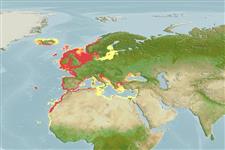Environment: milieu / climate zone / depth range / distribution range
Ecologie
marien; brak water demersaal; oceanodroom (Ref. 51243); diepte 0 - 150 m (Ref. 35388), usually 10 - 60 m (Ref. 6302). Subtropical; 8°C - 24°C (Ref. 4944); 64°N - 14°N, 25°W - 38°E (Ref. 54889)
Eastern Atlantic: southward from Trondheim Fjord (including North Sea and western Baltic) and Mediterranean Sea (including Sea of Marmara, Bosporus and southwestern Black Sea) (Ref. 4710). Elsewhere, southward to Senegal (Ref. 4710), including Cape Verde (Ref. 5304).
Lengte bij maturiteit / Grootte / Gewicht / Leeftijd
Maturity: Lm 30.3 range ? - ? cm
Max length : 70.0 cm SL mannelijk / geslacht onbekend; (Ref. 4710); common length : 35.0 cm SL mannelijk / geslacht onbekend; (Ref. 5504); max. gepubliceerd gewicht: 3.0 kg (Ref. 5504); max. gerapporteerde leeftijd: 26 Jaren (Ref. 32766)
Dorsale stekels (totaal) : 0; Dorsale zachte stralen (totaal) : 69 - 97; Anale stekels: 0; Anale zachte stralen: 53 - 80; Wervels: 46 - 52. This species is distinguished by the following characters: body oval, flat and asymmetric; eyes located on right side of head, except in reversed individuals (Ref. 57416). Upper eye less than its own diameter from dorsal profile of head (Ref. 4710). Anterior nostril on blind side not enlarged (Ref. 4710, 57416), but surrounded by small rim (Ref. 57416). Its distance from front margin of head 1.5-1.9x in its distance from cleft of mouth; anterior nostril on eyed side with backward-pointing tube not or only barely reaching front border of lower eye (Ref. 4710). Preopercle covered by skin and opercle entirely scaled; mouth arched and inferior; dorsal and anal fins lacking spinous rays and united to caudal fin by well-developed membrane, but caudal peduncle distinct; dorsal fin originating on horizontal axis through upper eye; pectoral fin on eyed side asymmetrical, with 7-10 rays, and on blind side slightly shorter; straight part of lateral line visible, supratemporal part slightly arched above eyes; body covered with rectangular ctenoid scales (Ref. 57416).
Adults occur at a temperature range of 8.0-24.0°C (Ref. 4944). Usually solitary. They burrow into sandy and muddy bottoms. Retreat to deeper water during winter (Ref. 9988). Juveniles are found during the first 2 to 3 years in coastal nurseries (bays and nurseries) before migrating to deeper waters (Ref. 92286). Adults feed on worms, mollusks and small crustaceans at night. Waden sea is the most important nursery area. Batch spawner (Ref. 51846). Recruitment is very variable. Frequently found pelagically during spawning migrations (Ref. 35388). Marketed fresh and frozen; utilized steamed, fried, broiled, microwaved and baked (Ref. 9988).
Spawning takes place in shallow coastal waters at temperatures of 6 - 12°C. Reproduction starts after 3-5 years of age, when 25-30cm size is reached. Spawning happens mainly during the months of February-May (for example, off the coasts of Galicia), although in warmer areas
(such as the Mediterranean), it can occur at the beginning of the winter. Incubation lasts about 5 days (at 1 2°) and larval phase 35 days (at 18°C).
Desoutter, M., 1992. Soleidae. p. 860-865. In C. Levêque, D. Paugy, and G.G. Teugels (eds.) Faune des poissons d'eaux douces et saumâtres d'Afrique de l'Ouest Tome 2. Faune Tropicale n° 28. Musée Royal de l'Afrique Centrale, Tervuren, Belgique and O.R.S.T.O.M., Paris, France, 902. (Ref. 7395)
Status op de Rode Lijst van het IUCN (Ref. 130435)
Gevaar voor de mens
Harmless
Gebruik door de mens
Visserij: van groot commercieel belang; Aquacultuur: commercieel; sportvis: ja; Aquarium: Publieke aquaria
Tools
Speciale rapporten
Download XML
Internetbronnen
Estimates based on models
Preferred temperature (Ref.
123201): 9 - 20, mean 11.4 °C (based on 678 cells).
Fylogenetische diversiteitsindex (Ref.
82804): PD
50 = 0.5020 [Uniqueness, from 0.5 = low to 2.0 = high].
Bayesian length-weight: a=0.00724 (0.00632 - 0.00830), b=3.07 (3.03 - 3.11), in cm total length, based on LWR estimates for this species (Ref.
93245).
Trofisch niveau (Ref.
69278): 3.2 ±0.1 se; based on diet studies.
Generation time: 3.9 (3.2 - 4.6) years. Estimated as median ln(3)/K based on 31
growth studies.
Weerstandsvermogen (Ref.
120179): Gemiddeld, minimale populatieverdubbelingstijd 1,4-4,4 jaar (K=0.21-0.33; tm=3-5; tmax=26; Fec=100,000).
Prior r = 0.50, 95% CL = 0.33 - 0.75, Based on 40 full stock assessments.
Fishing Vulnerability (Ref.
59153): Low to moderate vulnerability (35 of 100).
Climate Vulnerability (Ref.
125649): Moderate vulnerability (38 of 100).
Nutrients (Ref.
124155): Calcium = 79.8 [29.8, 184.5] mg/100g; Iron = 0.915 [0.416, 1.919] mg/100g; Protein = 18.3 [16.6, 20.1] %; Omega3 = 0.224 [0.141, 0.343] g/100g; Selenium = 17.2 [6.8, 47.5] μg/100g; VitaminA = 4.77 [1.36, 16.81] μg/100g; Zinc = 0.453 [0.263, 1.007] mg/100g (wet weight); based on
nutrient studies.
